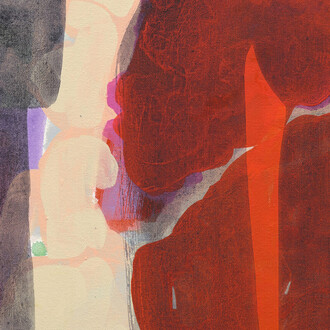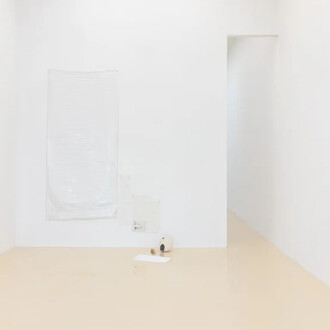Vielmetter Los Angeles is pleased to announce Andrea Bowers’s sixth solo exhibition with the gallery on view from September 14th through November 2nd, 2024.
In the exhibition entitled Recognize yourself as land and water, Bowers mourns the loss of old-growth forests due to industrial logging practices in the Pacific Northwest, where Humboldt and Mendocino counties in Northern California are critical sites in the fight to save the planet. Over decades, Bowers has visited this area and witnessed the destruction of the temperate rain forests, many of which include the stumps of 1,000-2,000-year-old trees. Visualizing themes of eco-grief and ecofeminism, the exhibition includes painting, sculpture, and video that situate Bowers’s work in the legacy of conceptual feminism’s merging of art and social activism.
In Recognize yourself as land and water, Bowers demonstrates how global ecosystems are interlinked. For example, if temperate rainforests are destroyed for corporate logging, farming, and ranching, local watersheds are devastated as well—what happens to the Amazon affects us locally. For this project, she focuses primarily on the Redwoods of Northern California but also includes work about the ecosystems around Lake Erie, in Ohio, and the Amazon, in South America. Additionally, Bowers highlights the work of many activists, including Northern Californian environmentalist and feminist Judi Bari, Brazilian founder of the National Articulation of Ancestral Warriors Women (Anmiga) Shirley Krenak, and Los Angeles-based poet and healer Deena Metzger; and groups Earth First!, Redwood Forest Defense, and Community Environmental Legal Defense Fund (CELDF).
A self-portrait of the artist on a massive old-growth tree stump is the inspiration for the exhibition and led to new cardboard works. In the compositions, women curl up or sit stoically on the stumps wearing dresses patterned with temperate rainforest foliage or barbed wire—symbols of reciprocity and protection. Through the paintings on cardboard, Bowers connects the resistance to patriarchal violence and environmental destruction.
Inspired by the long history of environmental activism in the Humboldt and Mendocino County areas where the historic “warrior society” group Earth First! was founded in 1980 and contemporary groups such as Redwood Forest Defense are still active, Bowers has witnessed how the tactics of mass logging industries ravage the forests by clearcutting old-growth trees. Landscapes we call home (2022) was shot in the summer of 2020 in Northern California and features Redwood Forest Defense tree-sitting activists. Bowers documented the Forest Defenders while exposing industrial logging company Green Diamond’s greenwashing tactics of harvesting old-growth trees for “eco-friendly” toilet paper and other products. In You can’t clearcut your way to heaven (2024), Bowers uses drone footage of stumps throughout Humboldt and Mendocino counties and incorporates audio from Earth First! speeches and folk songs from the 1990 Redwood Summer campaign spearheaded by Judi Bari. The irreverent and often fiery audio is a ghostly reminder of the battles to save the landscapes. The haunting footage reveals both the inherent beauty of the forest and the loss of old-growth trees.
Tree-sitting platforms (thrift store chairs) made of repurposed two-by-four wood planks and furniture, hang throughout the exhibition and serve as seating for the videos. The pieces continue a series of sculptural seating like those used in forest defense, a non-violent form of environmental protest where the activists put their bodies on the line by climbing in trees to prevent them from being cut down or developed.
Bowers was arrested in 2012 for tree sitting in an old-growth forest of 250 oak and sycamore trees in Arcadia, California. After being released from jail she went back to the site of the clearcut and filled a truck bed with the wood chip remains from mountainous piles on the site. Since then, she has been using these wood chips to create sculptures serving as memorials to these lost trees. Three new works in this series are included in the exhibition. Almost all the materials and colors come from the practice of tree-sitting; however, the P-cord, ropes, and gear are woven together with knots not only used for climbing but also friendship bracelets. The traditionally macho tree-sitting is given a decidedly femme edge. Suspended in these pieces are hand-blown colored glass orbs that contain the wood chips, as these woven works prioritize the emotional purpose of art in service of grief and remembrance. Selections of Metzger’s poetry are woven throughout the sculptures—always emotional and always political.
Bowers’s ongoing series Chandeliers of Interconnectedness underscores a foundational principle of ecofeminist thought—interconnectedness—which asserts that the exploitation of women, marginalized communities, and the environment are intrinsically connected. Bowers entwines a line from a poem—Her Leaves Are Fists—from Metzger along the branches of the chandelier made of recycled glass, repurposed steel, and neon leaves. This emphasis on interconnectedness underlies all the work on view in the exhibition.
Two other videos on view further Bowers’s intention to illuminate the work of activists to protect Mother Earth and fight globally for environmental justice. What we do to nature we do to ourselves (2024) documents the devastation of corporate farming on the ecosystem of Lake Erie in Ohio near Bowers’s hometown; Lake Erie is now under ecological threat as toxic algae blooms from corporate farming pollution. This video celebrates the activists and community members embroiled in the legal fight to protect water through Rights of Nature legislation. Raising the power (2024) features an interview with Amazonian eco-activist Shirley Krenak, of the Krenak people of the State of Minas Gerais, of the Atlantic Forest biome. Krenak works with the National Articulation of Indigenous Women Warriors of Ancestry and has dedicated her life to protecting the forests of the Amazon.
Andrea Bowers was born in 1965 in Ohio and lives and works in Los Angeles. She received her MFA from the California Institute of the Arts in 1992. Recent solo exhibitions include Andrea Bowers: Exist, flourish, and evolve at MoCA Cleveland, Cleveland, OH in 2024; Andrea Bowers, a survey exhibition which opened at the Museum of Contemporary Art Chicago in 2021 and traveled to the Hammer Museum, Los Angeles in 2022; Grief and hope, Museum Abteiberg, Mönchengladbach, Germany (2020); Light and gravity, Weserburg Museum fur modern Kunst, Bremen, Germany (2019-2020); Bureau of feminism, Hammer Museum, Los Angeles (2017); and Andrea Bowers: #sweetjane, Pomona College Museum of Art and Pitzer College Art Gallery, Claremont, CA (2014).
Recent group exhibitions include Rewilding, Kunsthaus Baselland, Basel, Switzerland; How to survive, Anchorage Museum, Anchorage, Alaska (2023); Language in the time of miscommunication, Scottsdale Museum of Contemporary Art, Scottsdale, AZ (2023); Working thought, The Carnegie Museum of Art, Pittsburgh, PA (2022); Empowerment, Kunstmuseum Wolfsburg, Wolfsburg, Germany (2022-2023); New time: art and feminisms in the 21st century, University of California, Berkeley Art Museum and Pacific Film Archive, Berkeley, CA (2021); Stories of resistance, The Contemporary Art Museum St. Louis, St. Louis, Missouri (2021); In plain sight, Henry Art Gallery, Seattle, WA (2019-2020); Climate change is real, Yerba Buena Center for the Arts, San Francisco, CA (2018); Half the picture: a feminist look at the Collection, Elizabeth A. Sackler Center for Feminist Art, Brooklyn Museum, Brooklyn, NY (2018); among others.
Her work is in the collections of the Museum of Modern Art, New York; the Museum of Contemporary Art, Los Angeles; the Hammer Museum, Los Angeles; the Hirshhorn Museum, Washington, DC; the Museum of Contemporary Art Chicago; San Francisco Museum of Modern Art, San Francisco, CA; the Tate Modern, London; Whitney Museum of American Art, New York; and many others.
















